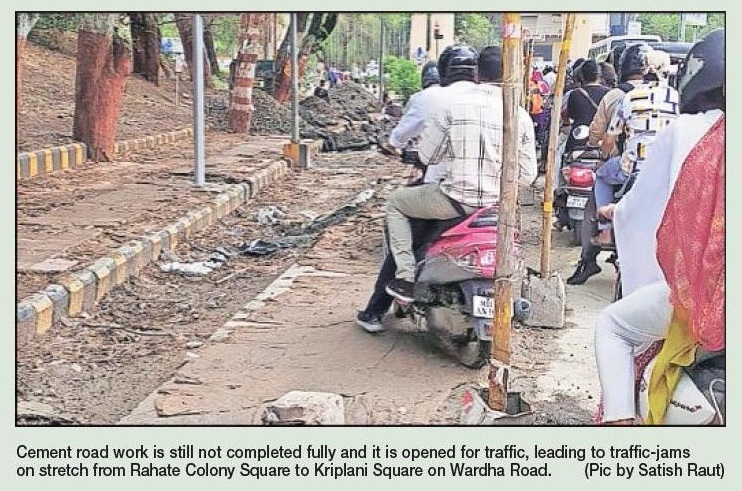Is Nagpur losing basic structure in hectic infra devpt? -- II
| Date :18-May-2023 |

By Kartik Lokhande :
“You are bang on!”
“As always, ‘The Hitavada’ has taken up right issue. We are grateful that your newspaper has been raising the issues that concern the common people of city.”
“Keep writing. We need such articles to motivate authorities to sit together and focus on proper urban planning before going ahead with infrastructure projects one after the other. The city needs development, but a planned one...”
These are just three of many comments ‘The Hitavada’ received on Wednesday after the publication of the first part of the article with the same headline as above. People tended to agree that in infrastructure push, the city of Nagpur was losing its basic character of a ‘not so fast paced and peaceful’ city. There are signs of growth -- on parameters of economic activity, investment, construction -- but it appears that enough attention is not being paid towards certain issues viz. traffic congestion, parking woes, old city charm getting overshadowed by tall concrete modernity, shrinking green spaces, fading heritage, increasing stress, violators not getting punished in proportion of enormity of violations etc.
Of course, there are activists who are trying to hold the fort and fighting the battle. But, even in case of activists, there is much to be desired. They oppose projects but often their resistance is not backed by scientific and methodical research done by them on local conditions. As a result, when authorities concerned come up with detailed booklets, even the well-intentioned opposition is not able to defend the city’s interests strongly. Mere social media posts bordering on trolling, do not serve the purpose. Rather, activism backed by data updates and sustained research on local issues can prove to be more impactful in securing long-term interest of the city. This provides a free hand to those believing that only physical infrastructure means development.

Those familiar with not only the ideas but also the ideals of urban design and planning know how important it is to
preserve city’s character reflected in its heritage. For the past several years, conservationists and eminent architects from the city like Paramjit Singh Ahuja have been suggesting to declare old city area of Mahal, which has several heritage structures, as Heritage Zone. It would have boosted economic activity with tourism, without compromising on heritage. However, since this has not happened, one has a reason to believe that there has been deliberate attempt to neglect heritage structures to allow those to wither away with time, and also to not think of sustainable economic activity. Time and development discourse dominated by construction activities both have taken a toll on water bodies of the city. The city’s signature Nag river has turned into a massive open drain. Same is the status of Pili river, Pora river.
The iconic Shukrawari Lake, Ambazari Lake, and Futala Lake are being ‘rejuvenated’ with more emphasis on construction and putting up a grand show than on preserving natural character of these water bodies. And, little does one realise that green spaces of the city also are becoming victims of neglect. Gradually, at many places, trees are being felled or are proposed to be felled to pave way for some more concrete constructions. Obviously, this is going to adversely impact the micro-climate. Sadly, again, there is no systematic and scientific study to assess the impact of developmental projects on local micro-climate.
There is very little awareness that changes in micro-climate could also affect public health. In fact, there is a big void in administration about understanding newer methods of health surveillance. Not many know that wastewater epidemiological surveillance holds a great promise in creating database of prevalence of various infections and drug consumption patterns in various areas. City-based scientists are working on such projects, but most authorities engaged in development discourse are unaware of this. There are several such dimensions to the city’s development (or, shall one say ‘growth’?) story. Of course, much of these reflections have been triggered by insightful conversations at the panel discussion organised by The Institute of Town Planners of India (ITPI) Maharsahtra Regional Centre, Nagpur. In response to the discussion moderator Dr Sarika Bahadure’s query, Dr Akshay Patil and this scribe both offered three keywords around which city’s image could be built.
Dr Patil focussed on tangible part of it when he mentioned thoughtful infrastructure, agriculture, and environment. This scribe focussed on values that the city should be identified with -- Openness for ideas, informed activism, and reasoned criticism; Deterrence among violators of traffic norms or other rules instead of only monitoring with the help of technology; and Informed (nor imposed) Aspirations so as to preserve basic structure and character of the city even while carrying out infrastructure development in city. Of course, this is not a one-time thing. For, city evolves and planners and stakeholders have to dynamically respond to changes and newer challenges. So, the most important thing is to streamline the process wherein there is scope for continuous brainstorming to make the city better even while staying time-relevant. For the purpose, on the lines of Police Department’s peace committees, ‘sustainable development local committees’ could be set up in various parts of the city by the multi-agency co-ordination committee for the entire city. These local committees must be non-political in nature with members representing experts from varied fields, who would assess any new proposal for infrastructure development on technical, social, economic, heritage, and environment parameters. The idea of these reports is to trigger thinking across cross-section of the society including planners, administrators, citizens and all stakeholders.